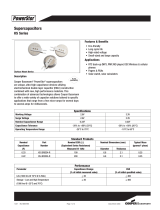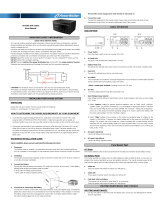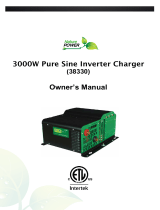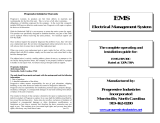
11
AC Shore Power – [“shore power” refers to AC input power from a utility grid, generator, or
other AC source.] To charge batteries and pass power on to an AC load, a source of nominal
115Vac, 60Hz is needed. This source is predominantly the utility grid (wall power, power
company) or an AC generator. In the case of multiple sources, an automatic or manual AC
source selector switch can be used.
The AC source going into the inverter must have a neutral conductor bonded to ground (i.e. 3-prong
wall cable). When the inverter is passing AC power through, it relies on the input being grounded to
ensure the power delivered to a sub-panel is bonded. See “AC Output Neutral Bonding” on page 12
for further information on bonding relay operation.
*Please note that the grid power source utilized must be branch breaker or branch fuse protected at 30
Amp maximum.
Generator – The inverter is capable of handling most generators that produce nominal
115Vac, 60Hz sine wave AC power. The current limit for DC charging is programmable to as little
as 2A, therefore a very small generator would be sufficient.
AC Disconnect and Over-Current Protection Device –
The inverter is required by safety and electrical codes to have AC and DC input/output over-
current protection (i.e. circuit breakers and/or fuses), as well as disconnect devices. The
following are suggested protective measures for each configuration:
AC Input: The branch fuse or branch circuit breaker (hard wired) used on the source
of the inverter must be rated to a max 30A and must also be approved for use on 115Vac
systems. The wire used between the breaker and the inverter needs to be sized
accordingly to pass the same amount of current rated for the fuse.
AC Output: The fuse or circuit breaker on the output should not be rated any higher
than that of the input. The wire between the inverter and the AC output breaker should
be rated to carry the amount of current rated for the fuse. Any subsequent wiring from
this output breaker to the loads must be sized accordingly for the current being passed to
each individual load. 1000 Watt models feature an integrated 15 Amp AC output breaker
while 1800 Watt models
feature an integrated 20 Amp AC output breaker.
Disconnect Devices: Each fuse or breaker system requires a method for disconnecting. If
the devices used are circuit breakers, these will serve as the disconnects. If they are fuses,
separate AC disconnect switches will be necessary ahead of the fuses; these switches will be a
branch circuit with proper current characteristics and rated to 120Vac.
AC Distribution Panels – A usual system will incorporate distribution centers ahead of the
inverter and between the inverter and the loads (AC load panel). AC source panels will include a
main circuit breaker, serving as the over-current protection and the disconnect switch for the AC
power supply. AC load panels can utilize an AC output circuit breaker, and breakers for each
subsequent load circuit.
CAUTION: Equipment damage – Do not connect the output of the inverter to what is
known as a “multi-wire branch circuit.”




























